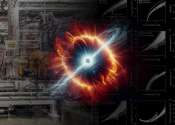A neutron star is a type of remnant that can result from the gravitational collapse of a massive star during a Type II, Type Ib or Type Ic supernova event. Such stars are composed almost entirely of neutrons, which are subatomic particles without electrical charge and roughly the same mass as protons. Neutron stars are very hot and are supported against further collapse because of the Pauli exclusion principle. This principle states that no two neutrons (or any other fermionic particle) can occupy the same quantum state simultaneously.
A typical neutron star has a mass between 1.35 and about 2.1 solar masses, with a corresponding radius of about 12 km if the Akmal-Pandharipande-Ravenhall (APR) Equation of state (EOS) is used. In contrast, the Sun's radius is about 60,000 times that. Neutron stars have overall densities predicted by the APR EOS of 3.7 to 5.9 × 1017 kg/m³ (2.6 to 4.1 × 1014 times Solar density), which compares with the approximate density of an atomic nucleus of 3 × 1017 kg/m³. The neutron star's density varies from below 1 × 109 kg/m³ in the crust increasing with depth to above 6 or 8 × 1017 kg/m³ deeper inside.. This is approximately the weight of the entire human population condensed into the size of a sugar cube.
In general, compact stars of less than 1.44 solar masses, the Chandrasekhar limit, are white dwarfs; above 2 to 3 solar masses (the Tolman-Oppenheimer-Volkoff limit), a quark star might be created, however this is uncertain. Gravitational collapse will always occur on any star over 5 solar masses, inevitably producing a black hole.









